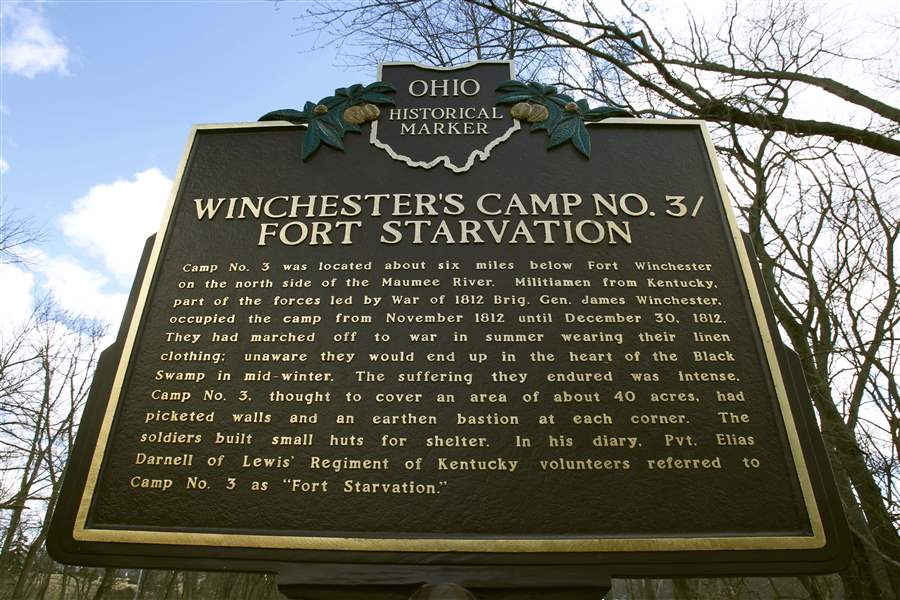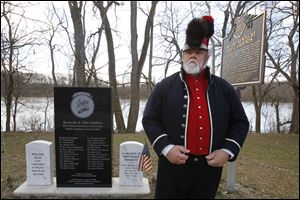
Region looks back on strife of war fought 200 years ago
3/11/2012
A marker commemorates Camp No. 3, where militiamen encamped in November and December of 1812.
The Blade/Lori King
Buy This Image
First in an occasional series

A marker commemorates Camp No. 3, where militiamen encamped in November and December of 1812.
DEFIANCE -- At a state park near Defiance, sunny spring days beckon bright, bringing life to the banks of the mighty Maumee River.
Families gather, tossing hot dogs, brats, and burgers onto smoky grills. They feast on potato salad, sliced melon, chips, and perhaps some pickles.
Dramatic is the difference 200 years after the War of 1812 brought death to the river area.
RELATED ARTICLE: Canada sees itself as a victor in 1812 war
Scads of soldiers died not from clashes of cannonballs but rather from the lack of food. It's called Fort Starvation for a reason.
At the area now known as Independence Dam State Park, about six miles below where Fort Winchester once stood, a historical marker tells the tragic tale of Winchester's Camp No. 3, where militiamen from Kentucky, part of forces led by War of 1812 Brig. Gen. James Winchester, occupied the camp from November through December in 1812.
Kentuckians had marched off to war in summer wearing their linen clothing, unaware they would end up slogging and shivering through Black Swamp snow drifts in midwinter.

Historian Richard Rozevink, in battle regalia, pauses near the Fort Starvation marker at Independence Dam State Park in Defiance. Remains were found during construction of the Miami and Erie Canal, which opened in 1845.
Their suffering was intense.
In his diary, Pvt. Elias Darnell of Lewis' Regiment of Kentucky volunteers, who referred to Camp No. 3 aptly as Fort Starvation, wrote about receiving skimpy provisions of salt, flour, and whiskey.
On some days, the men went without any salt and flour, mainstays of meals at the time. Weak from hunger, many soldiers were felled by disease and failure to thrive.
In his words, Nov. 4, 1812: "Four of this army have gone to the silent tomb today never more to visit their friends in Kentucky; the fever is very prevalent in camp; nearly every day there is one or more buried."
The horrors of Fort Starvation were unearthed during construction of the Miami and Erie Canal, which opened in 1845. Canal workers dug through the burial grounds of Winchester's Camp No. 3 and uncovered thousands of bones of soldiers who drew their last breaths, never again to return to their old Kentucky homes. They were buried in Ohio, honored by military rites with muffled drums.
In Ohio, Michigan, Indiana, Kentucky, and beyond, Americans are marking the bicentennial of the War of 1812 with a blend of star-spangled celebratory salutes and solemn remembrances of what is known as the Forgotten War or the Second War of Independence.
No matter the name, it was and always will be our war.
It happened here -- frontier skirmishes, fort battles, fierce massacres -- in and near such communities as modern-day Maumee, Perrysburg, Fremont, and Marblehead in Ohio, and, in Michigan, the city of Monroe.
When duty called, scrappy rag-tag soldiers bravely battled back the enemy. Their history is our history. Their victories, our victories. Blood was shed where today, two centuries later, we work, we live, we play.
An array of events
During the War of 1812 bicentennial, scores of international, federal, state, and local special events will take place: memorial services and museum displays, fife and drum parades, battle re-enactments and beer tastings, fireworks, tall-ship and lantern tours, lectures and library displays, conferences and workshops, living-history encampments, cannon and musket demonstrations, monument and marker dedications, and much, much more. Events already are being held; some others, because the bicentennial extends beyond this year, remain in planning stages.
The Defiance County Chapter of the Ohio Genealogical Society prepared for the bicentennial by placing historical markers at five historically significant sites in the county, including at Fort Starvation. The intent is to honor veterans who served at those sites and those who died there in defense of our country, said local historian Richard Rozevink, co-author of a tour guide, Campaigns of the Army of the Northwest 1812-1813, A Brief History.
The guide provides maps and driving routes for those who wish to follow the footsteps of 1812 soldiers, described by Mr. Rozevink as "a bunch of backwoods men" who beat the best army the world knew at that time. And in doing so, patriotic pioneers gained respect for our country and boosted our national pride, he said.
Officially, the bicentennial begins with a flourish on June 18 this year -- 200 years after President James Madison declared war on Great Britain.
Plans call for the Declaration of War to be read in each of Ohio's 88 counties, followed by tolling bells and the raising of 15-star flags, similar to those flown during the war.

All that pomp and circumstance befits the bicentennial of a war that mattered then and now.
"The War of 1812 was the last major war fought on Ohio ground. There were significant battles fought in our own backyard, in our own state," said Rick Finch, director of Fort Meigs along the Maumee River in Perrysburg. "It was the first major war America fought as a nation. It was a psychological war for independence in the new and sovereign nation, and we showed we would stand up and fight for what is ours."
Typically, when folks are asked what they know about the war, the answer is "precious little," said Mr. Finch who is button-poppingly pleased to hear about growing interest in the bicentennial. "Since January we have seen an uptick in people who want to learn more about the war," he said. "The bicentennial is really an opportunity to pique interest in a war that was fought here with real fighting and real battles."
The front line
Fort Meigs was the front line of American military operations in the Northwest Territory, Mr. Finch said. There, the British suffered their first setback of the Northwest Campaign when a detachment of American troops stood firm against the combined forces of British and Canadian soldiers and Tecumseh's warriors.
The War of 1812, remembered by some for the burning by the British of the White House and the battle that inspired Francis Scott Key to write the "Star-Spangled Banner," was fought for several reasons, including unresolved issues related to free trade, sailors' rights, and control of the "western country."
Although called the Forgotten War, it should be remembered as a critically important war that secured America's future, said Joseph H. Zerbey IV, chairman of the Ohio War of 1812 Bicentennial Commission.
"It was the last time we fought against our Mother Country. We solidified ourself as a nation that would not be trifled with," he said. "It was a horrendous war. A lot of men were killed and gave their life for their beliefs. In the end, America won, besting what were considered as far superior naval and armed forces, and the amazing victory on land and sea sent a clear message: 'This country means business, and don't mess with Americans.' "
The Ohio War of 1812 Bicentennial Commission, established by the 128th Ohio General Assembly, is planning, as fund-raising efforts continue, several activities to honor Americans who served in the war and to educate and raise awareness of residents of Ohio and of the nation about Ohio's role in the war.
Plans plans include development of a portable, educational exhibit featuring artifacts and a timeline of the war in Ohio that would tour the state, Mr. Zerbey said.
"Our main mission is to promote understanding of the importance of the war to the history of Ohio," said Mr. Zerbey, who is president and general manager of The Blade.
Americans, Canadians, British, and Native Americans died right here where we walk, right here in the Great Black Swamp, he said. "There is a lot of history in Ohio, and we want to make sure folks get to understand that."
The bicentennial commission, he said, is supporting activities that will be held in Ohio communities, including in the Put-in-Bay area where the Perry Group is coordinating the September, 2013, re-enactment of the tide-turning Battle of Lake Erie, complete with tall ships and hundreds of volunteer "recruits" who will portray crew members who took part in the battle.
A turning point
On Sept. 10, 1813, Commodore Oliver Hazard Perry defeated a British naval force on Lake Erie, giving the United States the upper hand in the Northwest.
Americans had reason to cheer news of the victory on the lake. The country had seen its share of defeats.
Between June, 1812, and February, 1813, the United States lost Fort Michilimackinac and Fort Detroit in the Michigan Territory and Fort Dearborn in the Illinois Territory, and the country suffered a major defeat at the Battle of the River Raisin in the Michigan Territory. Only Fort Wayne, in the Indiana Territory, withstood the British.
With Gen. William Henry Harrison's victory at the Battle of the Thames on Oct. 5, 1813, the war in the Northwest was all but over. Peace came after the December, 1814, signing of the Treaty of Ghent.
As Mr. Finch points out, the bicentennial not only honors the brave, patriotic people who defended our independence, but it celebrates 200 years of peace between the United States, Canada, and Great Britain.
Contact Janet Romaker at: jromaker@theblade.com or 419-724-6006.